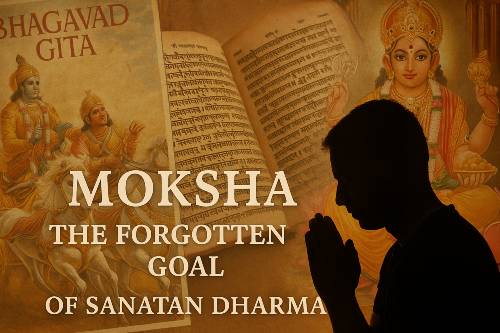In a world that constantly oscillates between chaos and clarity, the Bhagwad Geeta emerges as a timeless beacon of inner wisdom and spiritual direction. Revered across centuries, the Geeta is not merely a religious scripture—it is a dialogue that unravels the complexities of the human mind and the Nature of Reality. It continues to inspire seekers, scholars, scientists, and philosophers alike, bridging the ancient with the eternal.
Let us embark on a profound journey into the Bhagwad Geeta, weaving through Hindu Philosophy, Advaita Vedanta, and even the frontiers of Quantum Physics, to discover how its teachings remain strikingly relevant even today.
Bhagwad Geeta: A Song of the Divine
The Bhagwad Geeta, part of the epic Mahabharata, is a 700-verse conversation between Lord Krishna and the warrior Arjuna on the battlefield of Kurukshetra. More than a tale of war, this is an introspective exploration of the self, duty, righteousness, and liberation. It is a dialogue drenched in metaphysical depth and ethical inquiry—a discussion on Bhagwad Geeta that continues to echo in modern spirituality.
At its core, the Geeta encapsulates the essence of the Upanishads, the foundational texts of Hindu Philosophy. This sacred dialogue draws heavily from the Vedic understanding of the soul (Atman), the universe (Brahman), and the eternal truth that lies beyond material illusion (Maya).
The Trinity of Paths: Gyan Yog, Karm Yog, and Bhakti Yog
One of the Bhagwad Geeta’s most celebrated teachings is the presentation of three distinct spiritual paths:
-
Gyan Yog (Path of Knowledge): This path emphasizes the pursuit of truth through self-inquiry and wisdom. It is deeply connected to Advaita Vedanta, which teaches that the self (Atman) and the ultimate reality (Brahman) are one and the same. The Advaita Vedanta learning method encourages a rational investigation into the illusion of separateness, ultimately realizing non-duality.
-
Karm Yog (Path of Selfless Action): Here, the Geeta emphasizes performing duties without attachment to outcomes. This detachment is not apathy but a mindful surrender of the ego—a principle that resonates deeply with the Advaita Vedanta teaching of transcending the limited self.
-
Bhakti Yog (Path of Devotion): In this path, surrender and love towards the Divine are paramount. Lord Krishna presents Bhakti as the most accessible path, especially in times of moral confusion and emotional suffering.
Each path caters to different temperaments and mental inclinations. But ultimately, the Geeta integrates all three, guiding the seeker toward holistic self-realization.
Advaita Vedanta and the Geeta: A Unified Vision
To truly appreciate the Bhagwad Geeta, one must engage in a discussion on Vedanta—particularly Advaita Vedanta. This school of thought, consolidated by Shri Adi Guru Shankracharya, offers a non-dualistic interpretation of reality. According to Advaita, the world of multiplicity is a play of Maya, and liberation (Moksha) lies in realizing the oneness of existence.
Shankracharya’s Advaita Vedanta understanding of the Bhagwad Geeta positions Lord Krishna not just as a divine charioteer but as the Atman, the indwelling Self. His call to Arjuna to fight is symbolic of the inner battle every human must face—to transcend ignorance and act from the higher Self.
Through Advaita Vedanta course material and articles on Advaita Vedanta, we learn how the teachings of the Geeta are not contradictory to action but are a clarion call for right action—rooted in wisdom and non-attachment.
Quantum Physics and the Nature of Reality
Modern science, particularly Quantum Physics, intriguingly echoes several philosophical tenets from the Bhagwad Geeta and Upanishad teachings. Both propose that what we perceive as “real” is, in fact, an illusion of the senses. Just as quantum mechanics questions the objectivity of matter and observes the role of consciousness in shaping reality, so too does Advaita Vedant challenge the duality between observer and observed.
This alignment has led to an increase in interdisciplinary discussion on Upanishads, the Nature of Reality, and ancient metaphysics. Scientists and sages are increasingly discovering that both traditions point toward a unified, interdependent cosmos—one in which the distinction between self and other dissolves.
A Sacred Space for Inner Transformation: Brahmasmi.world
For modern seekers eager to dive deep into Advaita Vedanta learning and the teachings of the Bhagwad Geeta, platforms like Brahmasmi.world offer an oasis of collective wisdom. More than just a repository of sacred knowledge, Brahmasmi.world is a dynamic spiritual hub where ancient teachings meet contemporary insights.
Whether you’re beginning your Advaita Vedanta course, looking to participate in a discussion on Vedanta, or seeking live Satsangs, Brahmasmi.world serves as a bridge between intellectual understanding and spiritual embodiment. It’s a rare space where seekers across backgrounds unite in the pursuit of Self-realization.
Relevance in Modern Life
The true genius of the Bhagwad Geeta lies in its applicability to daily life. In the midst of ethical dilemmas, emotional breakdowns, or existential confusion, the Geeta whispers ancient truths in modern tongues:
-
In careers and choices, it teaches detached involvement.
-
In relationships, it promotes love without possession.
-
In mental well-being, it offers meditative equanimity.
-
In crises, it invokes strength through surrender.
The discussion on Bhagwad Geeta is not just an academic venture; it is a personal dialogue with the Self. The more one reflects on its verses, the more layers of truth are revealed.
Conclusion: Living the Geeta
The Bhagwad Geeta is more than a spiritual classic—it is a psychological manual, a philosophical masterpiece, and a timeless roadmap to transcendence. When integrated with Advaita Vedanta teaching, it becomes a guiding light that dissolves dualities and awakens the Self.
In today’s hyper-connected yet spiritually fragmented world, there is a deep hunger for meaning. The Geeta satisfies this hunger—not through blind belief, but through Gyan Yog, Karm Yog, and Bhakti Yog, inviting each individual to walk their unique path toward truth.
As you contemplate the verses of the Geeta, remember this: the battlefield is not somewhere outside—it is within. And the voice of Krishna still speaks—not from a chariot in Kurukshetra, but from the still center of your own being.
